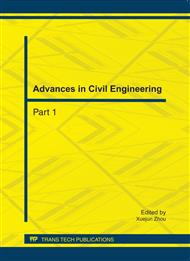[1]
Quansheng Ge, Ming Zou, Jingyun Deng, et al. Preliminary study on integrated assessment of the China natural disaster risk [M]. Beijing: Science Press, 2004:329-348.(In Chinese)
Google Scholar
[2]
Fenghua Zhang, Lili Xie, Lichu Fan. Studies on evaluation of cities' ability reducing earthquake disasters[J].ACTA Eismologica Sinica, 2004(3):349-361.
DOI: 10.1007/s11589-004-0057-6
Google Scholar
[3]
Yu Zheng. Research on evaluating index of ability for urban earthquake disaster reduction and requirements for emergent rescue[D]. Nanjing College of Civil Engineering of Nanjing University of Technology, 2003. (In Chinese)
Google Scholar
[4]
Wei Wang, Yang Han, Yueping Zhao. Secondary fuzzy comprehensive evaluation about the ability of a city defending earthquake disasters by AHP[J]. Building Technique Development, 2006, 33(4):1-3. (In Chinese)
Google Scholar
[5]
Wei Wang, Donghui MA, Jingyu SU, et al. Comprehensive evaluation for cities ability of reducing earthquake disasters based on cloud model[J]. Journal of Beijing University of Technology. 2010,36(6):764-770. (In Chinese)
Google Scholar
[6]
Zhanglin Guo, Mingguang Liu, Gaoyang Li, Secondary fuzzy comprehensive evaluation on cities' ability reducing earthquake disasters by group decision[J]. Building Technique Development, 2004, 31(2): 62-78. (In Chinese)
Google Scholar
[7]
Ting Yang. The risk index of urban earthquake disaster in the local and its application in Shanghai[J].Recent Developments in World Seismology. 2002(2): 4-7. (In Chinese)
Google Scholar
[8]
Fei Wang, Jianqun Jiang. Discussion on the methods analyzing urban earthquake vulnerability[J]. Journal of Seismological Research. 2005,28(1): 95-101. (In Chinese)
Google Scholar
[9]
Chongfu Huang. Risk assessment of nature disaster theory & practice[M]. Beijing: Science Press, 2005. (In Chinese)
Google Scholar
[10]
Qinhua Gao. Preliminary study on the basis of regional disaster reduction capacity in China[M].Beijing: Meteorological Press.2006. (In Chinese)
Google Scholar
[11]
Mingyuan Zhang. Research on the assessment of disaster-carrying capability and disaster comprehensive risk in urban place[D]. School of Civil and Hydraulic Engineering, Dalian University of Technology.2008. (In Chinese)
Google Scholar
[12]
Hongqi Wang , Xueyuan Wang. Fractal evaluation on allocation effect of regional science and technology innovation resources[J]. Technology Economics. 2008, 27(1): 1-5. (In Chinese)
Google Scholar
[13]
Yanguang Chen. Fractal urban systems: scaling. symmetrical. spatial complexity[M]. Beijing: Science Press,2008. (In Chinese)
Google Scholar
[14]
Jusheng Song, Enzhang Guo. Application of fractal dimension in evaluation of urban comprehensive strength[J]. Journal of Harbin Institute of Technology. 2006(8):1213-2215. (In Chinese)
Google Scholar
[15]
Chichen Qin. The principle and application of regional system model[M]. Beijing: Science Press, 2004:329-348. (In Chinese)
Google Scholar


